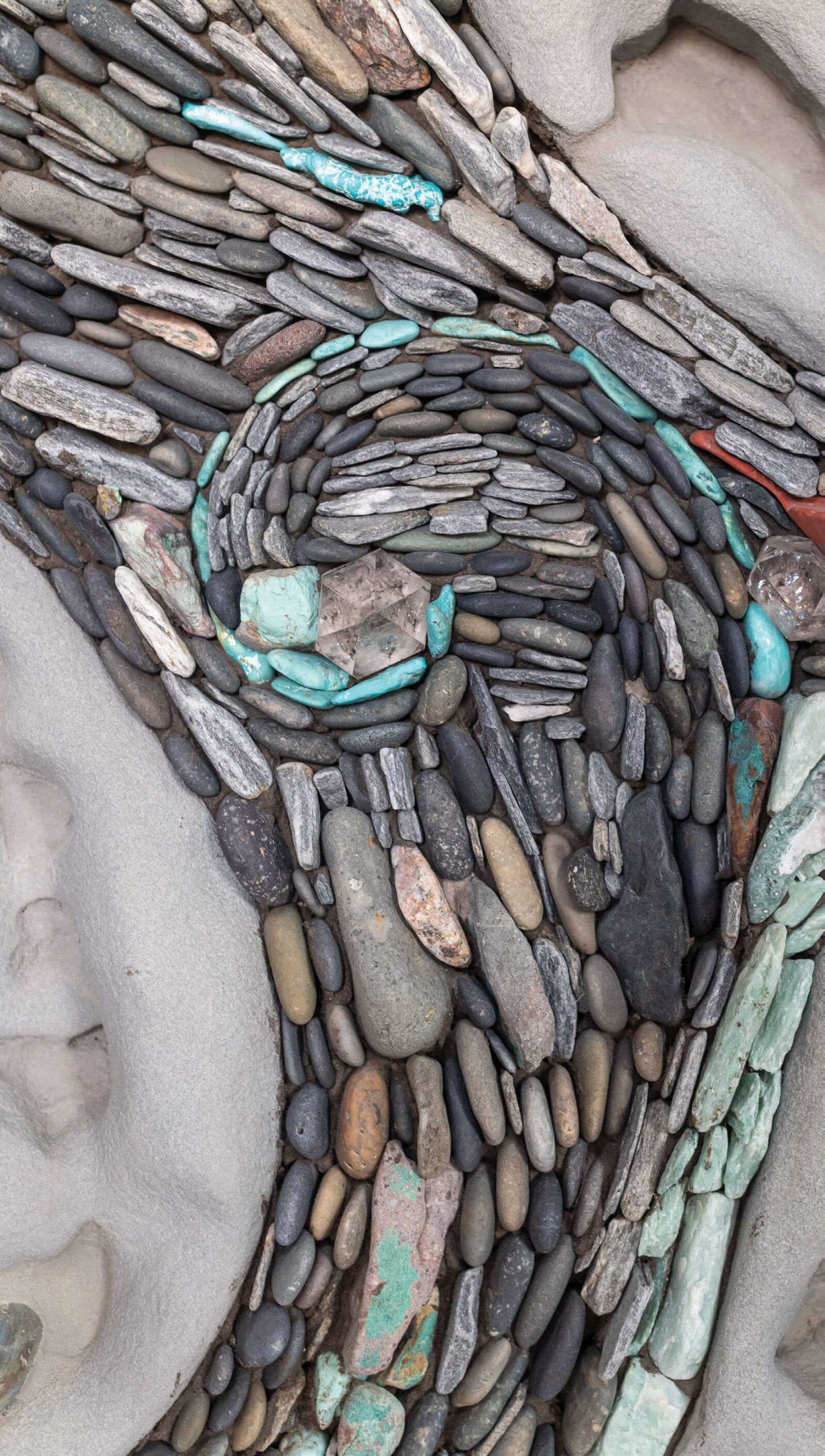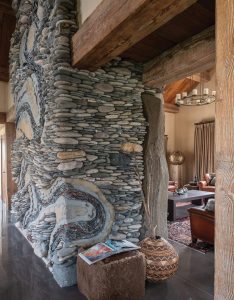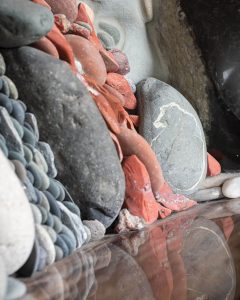
10 Apr Timeless Methods: The Rocks of Ages
There is an art to collecting rocks. Everywhere Gary Rieschel, his wife, Yucca, and their children have traveled, they’ve brought back souvenirs of those places. They’ve gathered small rocks and stones from beaches and riverbeds, in barren deserts, and on precipitous mountain outcroppings during their family forays to Indonesia, China, Greece, Turkey, Egypt, Taiwan, and many other countries.

A view of the completed fireplace from the main living area reveals a depiction of the East Gallatin River.
Andreas Kunert and his wife, Naomi, are collectors of rocks, too — basalt, jade, granite, amethyst, quartz, and petrified wood — and they use their finds to build fireplaces and chimneys that are likely to endure as long as the materials from which they’re made. The largest such fireplace they have built since co-founding their Vancouver Island-based company in 2010, Ancient Art of Stone, measures 24 feet tall, 12 feet wide, and 8 feet deep, and warms the Rieschels’ Bozeman, Montana home. That fireplace — as much a work of sculpture as it is a practical element that also supports the roof — is composed of rocks collected by the Kunerts and stones saved over the years by the Rieschels.
“Many of the stones that are important to our family from our 20 years or so of wandering around the world are now part of this composition,” says Rieschel, an investment industry executive who lives in Seattle but built this three-bedroom Montana house as a third residence. “Once I became interested in fly fishing, I searched for the right plot of land near the East Gallatin River,” he adds, “and that’s where we built the house.”

The fireplace was assembled in pieces. After the lower portion was placed on the foundation, a firebox was then inserted, followed by the second piece. Due to its overall height — 24 feet — the fireplace could not be trucked to the site except in pieces. photo by andreas kunert
One of the first features to go into place at the home, which was designed by the legendary (now retired) architect Jonathan Foote in 2019, was the fireplace, a creation the Kunerts refer to as “stone art.” After nine months spent building the fireplace, configuring an artwork made solely of stones and artifacts with personal connections to the Rieschels, the Kunerts trucked it 900 miles from their workshop. A special concrete foundation for the fireplace was poured and set within the home’s overall foundation. Once some rudimentary framing was erected, pins were then positioned in what would be the home’s main living area into which the assembled stone structure was lowered by crane.
Andreas recalls that tense moment when the two portions of the 42,000-pound fireplace were held aloft and each lowered into place. “We know how to calculate weights and the right cranes needed for the task given the weight of what we make,” he says. “But in this case, the wrong-sized crane arrived on site. We needed a 300-ton crane, but the one brought to the site was a 90-ton. The operator said, ‘Andreas, this weighs more than my crane can hold.’”

The sheer breadth of the fireplace is revealed as it serves to separate the main living area from the entrance foyer. The moment visitors enter the home, the pattern depicted on the fireplace is easily discerned, which shows — in stones — the flow of the East Gallatin River as it ebbs through the Rieschels’ property.
That discomfiting remark certainly gave the Kunerts pause, but they persevered since the replacement crane was many hours away. “The operator was able to get it up just high enough to drop into place,” Andreas continues. “He told me that if the first piece lands in what is the bathroom, that’s where it’ll have to stay,” Andreas says with humor. “It dropped right on the spot [in the living room], landing perfectly. It was one of those meant-to-be moments.”
Meanwhile, the Rieschels were there in spirit. “We weren’t at the site for installation, but we heard about every single terrifying moment of getting it in place and lining it up perfectly,” says Rieschel.
While some might consider that perfect, decisive landing of a massive structure an almost divine act of nature, the actual rocks that figure into the fireplace and chimney do possess sacred properties, according to Naomi. As a shaman and someone who was intimately exposed to Cree and Lakota cultures while growing up in Saskatchewan, Naomi believes that rocks possess an inherent energy and also a kind of spirit that needs to be acknowledged. “It’s a very spiritual process when you work with us to build something like this,” she says. “Stones and rocks speak; not literally, but they do convey their energy and meaning. Stones have the ability to emotionally move people. We believe that these stones help stabilize and bring balance and good energy into a home.”

The home, designed by Jonathan Foote in 2019, comes into full view from one of three trout pools that are situated on the land.
So attuned are Andreas and Naomi to the hues and properties of the rocks they use to construct fireplaces that they seem to always be looking, consciously and subconsciously, for the right ones to reflect their clients. Uncannily, for instance, during the initial design phase of the Rieschels’ fireplace, Andreas recalls Rieschel telling him that he felt a particular connection to and fondness for bears. “‘Can you bring an image of a bear, somehow, into the fireplace?’” Andreas recalls him asking. “One day, Naomi and I were walking along the shoreline of a remote Vancouver island, and I spotted a granite stone in the surf shaped exactly like a bear.” Indeed, that eerily evocative 10-inch stone now figures prominently in the composition.
Rieschel has built several homes for his family, and in each one, he wants something distinctive, some element or detail that defines one house from another. “I always try to find that signature piece for a home so that the moment someone walks in and sees it, they can say that’s our home and no one else’s.” He and his wife commissioned Andreas and Naomi after seeing some of their work in a Western Art & Architecture feature. “I called them up and told them a little about what I wanted for this home, and they flew to Seattle to meet with me,” he recalls. “Right away, I could tell that they ‘got’ the spiritual nature of this property. They understood that intimate connection to nature.”

The homeowner wanted an image of a bear included somewhere on the fireplace; while the Kunerts were walking a beach on a remote Vancouver island, they came upon a rock etched with quartz in a configuration that appears to replicate a bear. The particular stone is especially well reflected in a rare piece of opalized petrified wood.
After much searching, Rieschel settled on an expansive acreage of land in the township of Belgrade, Montana, just outside of Bozeman. The East Gallatin River runs through the property, which he characterizes as “a very subtle, beautiful piece of bottomland near the end of the valley.” It’s near there, in fact, that the East Gallatin River joins the Jefferson and Madison rivers to eventually form the mighty Missouri River. For the artwork that would appear on the surface, Rieschel had the idea to take aerial photographs of the land and meanderings of the East Gallatin, complete with its small green islands, tributaries, and sinuous profile. That shape of the river, exactly as it flows through the land, is the most conspicuous form on the fireplace, a design composed of stones at once seemingly abstract, yet realistic. “While a river motif is common for us, here it’s this river, the East Gallatin,” explains Andreas. “It’s very vividly rendered and specific to this artwork and to this family.”
He and Naomi emphasize that, for every project they undertake, they choose each stone and set every one in place, bonding the elements with clear polymers and epoxy. What begins as a sketch eventually morphs into the actual fireplace. “We try to bring to the client, through the drawings, a general understanding of what we’re proposing for the artwork,” Andreas explains. “But we never want to corral ourselves too much.” Just as the stones are shaped by natural forces, so, too, in a sense, do the Kunerts embrace an organic approach to the design. While the engineering and structural aspects of the fireplace — which they thoroughly understand and integrate — are immutable, the artwork takes its form as the making of it commences. “I listen to the stones at that point,” he adds.
Andreas and Naomi are not only great craftspeople and artists but also philosophers of stone, rock, and the spiritual importance of working with such materials. With every commission, they encourage their clients to talk of their pasts, their ancestors, the months they were born; such facts often determine the stones chosen. The couple travels to the actual locales of the stone they envision using in their projects — whether it’s quarries in Brazil or sources for petrified wood in the Arizona wilderness. “One time, many years ago, I was in Boston in a stone yard,” Andreas recalls. “I overheard the owner yelling to someone on the phone, ‘You should never buy stone over the phone!’ I’ve never forgotten that, and that’s what we do now; go to the stone, right where it is in the earth.”
Some might compare the placing of individual rocks and artifacts, such as the “lucky” Asian coins in the Rieschel piece, to creating a mosaic. Though true, every element within the composition has also been subjected to special treatment and assessment. The vast array of smoothed, oblong rocks that form the main composition are not river rocks, as some would assume, but rather from desert locales where they formed eons ago through glacial forces. “We tumble the rocks for a week or month, which results in these finished shapes,” says Andreas. For the two large basalt rocks that appear to anchor the fireplace visually, their arresting black hues are the result of Andreas and Naomi having sanded away the oxidized brown surfaces formed over millennia. Elsewhere, the gleam of Herkimer diamonds (essentially quartz), along with turquoise, moonstones, copper, and other formations stand out. With every gaze at the fireplace, new details emerge. The structure is as hypnotic as the roaring fire within it.
As for the house’s architecture, Rieschel commissioned Foote (who also designed Rieschel’s house in Montana’s Yellowstone Club) because, as the homeowner says, “He’s the real deal.” Rieschel cites Foote’s lifelong penchant for using reclaimed wood, stone, and metal in the homes he designs. “All of the wood in this home is reclaimed. All of the fir is from an old mill in Oregon. The redwood comes from railroad tunnels between Oregon and California from the 1850s, and there’s even a lot of reclaimed corrugated steel elements. Jonathan was doing this kind of thing 40 years ago when others weren’t.” Rieschel recounts, too, the siting of the house, and how he and Foote toured the land by foot, stopping to frame rooms before they were built to ensure they would focus on specific views of the mountain ranges that loom in the distance. “Jonathan’s a gifted architect.”
The house is well in place, and its most prominent interior element remains the one everyone comments on upon entering. “We hosted a ceremony to inaugurate it,” says Rieschel. “It was very moving and authentic, and involved sacred prayers, the cupping of smoke, the burning of herbs.”
As for Andreas’ passion for what he and Naomi make, he says, “I love the permanent quality of the materials we use. I’m always inspired by the thought that when I build this, and long after I’m gone, this will still be standing. The house may be rebuilt, but the intention is that this will have longevity.”
David Masello writes about art, architecture, and culture for many publications, including Milieu, of which he is the longtime executive editor. He has written three books about art and architecture and many of his one-act plays and monologues — which he often performs — have been produced by theater companies in New York City and Los Angeles. He is on the board of New York City’s National Arts Club.
Visual artist Audrey Hall is known for her poignant landscapes, evocative images of wild places, and luxurious interiors. Her art is part of the TIA Collection, whose unique purpose is lending significant works to museums and institutions. She brings the rigor of her fine arts and architectural background to the challenges of creativity, resulting in a growing collection of celebrated books, features, and creative projects.




No Comments